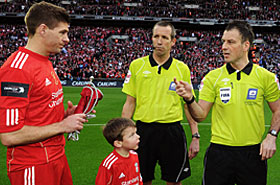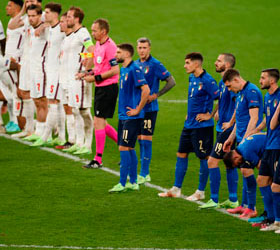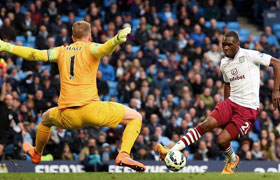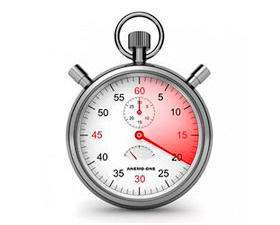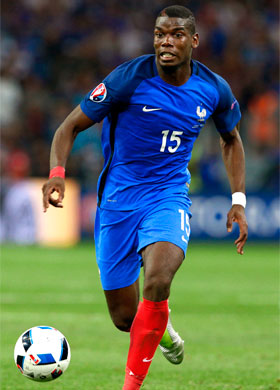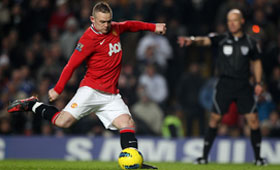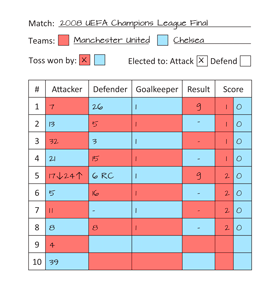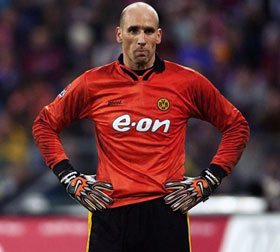Before ADG starts
Law 1 Unless there are other considerations (e.g. ground conditions, safety etc.), the referee tosses a coin to decide the half of the field where ADG will take place, which may only be changed for safety reasons or if the goal or playing surface becomes unusable. is self-explanatory and is similar to the law Unless there are other considerations (e.g. ground conditions, safety etc.), the referee tosses a coin to decide the goal at which the kicks will be taken which may only be changed for safety reasons or if the goal or playing surface becomes unusable from Penalties (penalty shoot-out), which requires the referee to toss a coin to decide the goal where the kicks take place.
Law 2 The referee tosses a coin again and the captain of the team who wins the toss, decides whether to attack or defend in the first contest. is self-explanatory and is similar to the law The referee tosses a coin again and the team that wins the toss decides whether to take the first or second kick from Penalties (penalty shoot-out), where the team winning the toss has the choice of kicking first or second.
Law 3 If at the beginning of ADG one team has more players on the field than the other, they maintain that advantage. is designed to encourage fair play. Teams who received red cards during normal play will be at a disadvantage during ADG. See example.
Law 4
The referee meets separately with each team and records their five attackers and the order in which they will compete.
requires each team to designate their five attackers
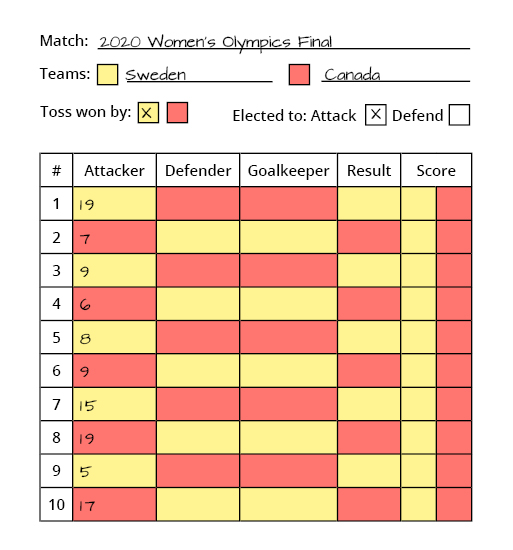 with the referee prior to the start of ADG. If a team has had a player or players sent off during the match, the law ensures the team still fields an attacker for five contests.
with the referee prior to the start of ADG. If a team has had a player or players sent off during the match, the law ensures the team still fields an attacker for five contests.
Law 5 A goalkeeper is ineligible as an attacker. is self-explanatory.
During ADG
Law 6 Only the eligible players and match officials are permitted to remain on the field of play. is identical to the law Only eligible players and match officials are permitted to remain on the field of play from Penalties (penalty shoot-out), which allows only the eligible players and match officials to remain on the field of play.
Law 7 The players currently not competing must remain within the centre circle in the disused half of the field and will be supervised by an assistant referee. is similar to the law All eligible players, except the player taking the kick and the two goalkeepers, must remain within the centre circle from Penalties (penalty shoot-out), and requires the players who are currently not competing to remain within the centre circle in the disused half of the field. An assistant referee will supervise these players.
Law 8 The attacking team's goalkeeper must remain a safe distance behind the assistant referee who is positioned behind the goal line. is similar to the law The goalkeeper of the kicker must remain on the field of play, outside the penalty area, on the goal line where it meets the penalty area boundary line from Penalties (penalty shoot-out), which designates the positioning of the goalkeeper who is the team-mate of the current kicker.
Law 9 If a team is unable to field their designated attacker or an eligible substitute, the team will forfeit that contest. describes how a team will forfeit a contest if they are unable to field an attacker. This would occur if the player was sent off. Another example is an attacker who is injured, with his team having already their additional substitution.
Law 10 After seeing the attacker, the opposing team fields their defender. describes how the decision to field a specific defender is made only after seeing the opposition's attacker.
Law 11 Players designated as attackers are ineligible as a defender. is self-explanatory.
Law 12 If a team is unable to field a defender or an eligible substitute, the attacker will compete one-on-one against the goalkeeper. describes how an attacker is allowed to go one-on-one against the goalkeeper. This arises if one team begins ADG with more players than the opposition.
Law 13 The defender and goalkeeper must be at least 9.15m (10 yards) from the ball until it is in play. is similar to the law For every kick-off: the opponents of the team taking the kick-off must be at least 9.15 m (10 yds) from the ball until it is in play from The Start and Restart of Play, which requires opponents to be at least 10 yards from the ball until it is in play.
Law 14 Half of the field is in play. is self-explanatory.
Law 15 The attacker kicks off from the ADG mark and has twenty seconds to try and score a goal. designates kick-off from the ADG mark, which is 29.26m (32 yards) from the goal line. The law also stipulates a twenty second time limit. This mitigates against a standoff between the attacker and the defender. Twenty seconds ensures urgency, but also provides ample time for unpredictable and exhilarating contests.
Law 16 The attacker may touch the ball an unlimited number of times. is included to circumvent The Start and Restart of Play law that states, "If the player taking the kick-off touches the ball again before it has touched another player, an indirect free kick, or for a handball offence a direct free kick, is awarded."
Law 17 If a goal is scored, the contest is over. is self-explanatory.
Law 18 If the ball goes out of play, the contest is over. stipulates that a contest will end if the ball goes out of play. Both the referee and the assistant referee on the goal line will adjudicate on whether a ball is in or out of play.
Law 19 If the goalkeeper controls the ball with their hands inside the penalty area, the contest is over. and Law 20 If twenty seconds elapse, the contest is over. are self-explanatory.
Law 21 If the attacker commits a foul, the contest is over. is self-explanatory and an example is an attacker who loses possession of the ball and fouls the defender while trying to regain it.
Law 22 If the defender or goalkeeper commits a foul, the attacker is awarded a penalty kick, and the twenty second time period is disregarded for the remainder of the contest. stipulates a penalty kick if the defender or goalkeeper commits a foul. As the twenty second time period is disregarded, the contest will conclude when one of the following occurs: (a) a goal is scored, (b) the goalkeeper controls the ball with their hands inside the penalty area, (c) the ball goes out of play, or (d) the attacker commits a foul or an offence as described in Law 23 or Law 24.
Law 23 If before the penalty kick has been taken, the attacker commits an offence that would normally result in the defending team receiving an indirect free kick, the contest is over. is self-explanatory and an example is an attacker who during the penalty kick, feints to kick the ball after completing their run-up.
Law 24
If after the penalty kick has been taken, the attacker touches the ball again (with any part of the body), before it has touched another player, the contest is over.
is similar to the law
If, after the penalty kick has been taken:
the kicker touches the ball again before it has touched another player:
an indirect free kick (or direct free kick for a handball offence) is awarded
from The Penalty Kick, which stipulates a free kick if the kicker touches the ball again before it has touched another player.
Law 25 If an incident occurs that would normally require play to be restarted by a dropped ball, the contest must be restarted. is self-explanatory.
Law 26
The referee keeps a record of the contests.
requires the referee to keep a record
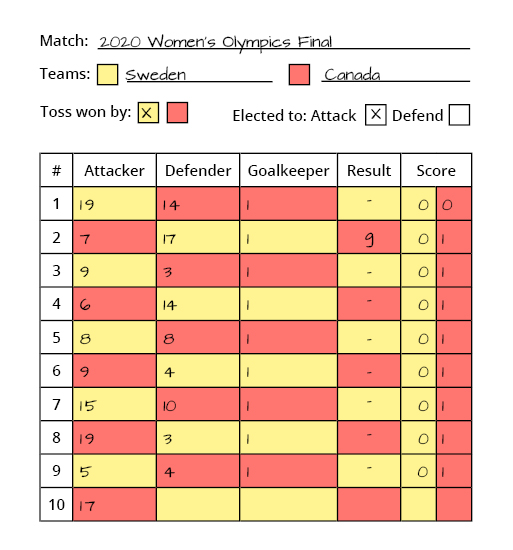 of the contests. While they have already recorded the attacking players, as each contest unfolds, they also record: the defenders and goalkeepers, if a goal is scored, and the score. Download referee's scorecard.
of the contests. While they have already recorded the attacking players, as each contest unfolds, they also record: the defenders and goalkeepers, if a goal is scored, and the score. Download referee's scorecard.
Law 27 An eligible player may change places with the goalkeeper. is identical to the law An eligible player may change places with the goalkeeper from Penalties (penalty shoot-out), which allows an outfield player to become the goalkeeper. This situation may arise in ADG if a goalkeeper is sent off or injured, with the team having already used their additional substitution. Any on-field attacker or defender can become the goalkeeper, and this is regardless of whether the player has already competed in a contest.
Law 28 With the exception of the condition explained above, players may not change places. is self-explanatory and an example would be a team with an injured defender. A player who is already on the field may not change places with the injured player. Of course, if the team still has their additional substitution available, they can simply replace the injured player with a substitute.
Subject to the conditions below, the teams play a total of ten contests
Law 29 Teams take turns attacking and defending. is similar to the law The kicks are taken alternately by the teams from Penalties (penalty shoot-out), which requires five kicks to be taken alternately. The teams take turns at being the attacking and defending team.
Law 30 With the exception of each team's goalkeeper, a player is not allowed to compete in a second contest until all eligible players on both teams have competed in a contest. is self-explanatory and is similar to the law Each kick is taken by a different player and all eligible players must take a kick before any player can take a second kick from Penalties (penalty shoot-out), where each kick is taken by a different player and all players must take a kick before any player can take a second kick.
Law 31 If before the completion of the ten contests, one team has scored more goals than the other could score, even if the contests were to be completed, no more contests will occur. is self-explanatory and is similar to the law If, before both teams have taken five kicks, one has scored more goals than the other could score, even if it were to complete its five kicks, no more kicks are taken from Penalties (penalty shoot-out), where if one team has an unassailable lead, the match is over.
Law 32 If at the completion of the ten contests, the scores are level, then the contests continue with the same order of players, until one team has scored one more goal than the other from the same number of contests. is similar to the law If, after both teams have taken five kicks, the scores are level kicks continue until one team has scored a goal more than the other from the same number of kicks from Penalties (penalty shoot-out), which describes the sudden death procedure that occurs if scores are still level after the ten kicks. The players from the first contest will now compete in the first sudden death contest.
Substitutions, cautions and sending-offs during ADG
Law 33 Teams receive an additional substitution and corresponding substitution opportunity. allows each team an additional substitution and corresponding opportunity. If teams suffer an injury during ADG, the additional substitution ensures that they will not be unfairly disadvantaged. Any unused substitutions from normal play are also carried forward into ADG. However, to prevent the number of substitutions from becoming unwieldy and slowing the game down, they can only be utilised within the same substitution opportunity. See the Q&A.
Law 34
A defender or goalkeeper who commits an offence which denies the attacker an obvious goal-scoring opportunity, is not cautioned or sent off unless:
• The offence is holding, pulling or pushing, or there is no attempt to play the ball or challenge for the ball, in which case the player is cautioned.
• The offence is one which is always punishable by a yellow or red card. (e.g. reckless or excessive force challenge)
• The offence is handball, in which case the player is sent off.
addresses offences that deny the attacker an obvious goal-scoring opportunity (DOGSO). With the attacker competing against just a defender and goalkeeper, goal-scoring opportunities will be a normal occurrence. Therefore, to avoid an excessive number of sanctions, the punishments cannot be as severe as during normal play. Moreover, as a foul on the attacker always results in a penalty kick (a very good opportunity to score), the goal-scoring opportunity lost by the offence is always restored. So, regardless of whether the offence occurs inside or outside the penalty area, if the foul is careless, the player is not cautioned or sent off.
However, to discourage unfair play and analogous to The Laws of the Game, Where a player commits an offence against an opponent within their own penalty area which denies an opponent an obvious goal-scoring opportunity and the referee awards a penalty kick, the offender is cautioned if the offence was an attempt to play the ball or a challenge for the ball; in all other circumstances (e.g. holding, pulling, pushing, no possibility to play the ball etc.) the offending player must be sent off. holding, pulling or pushing, or any offence which is not an attempt to play the ball or challenge for the ball, receives a yellow card. Of course, reckless or excessive force challenges remain yellow and red card offences, respectively. Finally, a handball DOGSO remains a red card offence.
| Denying an Obvious Goal-Scoring Opportunity (DOGSO) | Sanction |
| Careless foul | None |
| Reckess foul | Yellow Card |
| Holding, pulling or pushing, or no attempt to play the ball, or challenge for the ball |
Yellow Card |
| Excessive force foul | Red Card |
| Handball | Red Card |
Law 35 The referee must not abandon the match if a team is reduced to fewer than seven players. is identical to the law The referee must not abandon the match if a team is reduced to fewer than seven players from Penalties (penalty shoot-out), and requires the referee to continue with ADG even in the event of a team having less than seven players on the field.

"One does not remember the winners.
One remains haunted by the losers."

